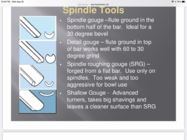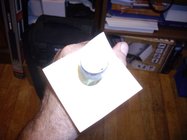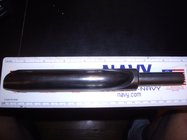I had spindal gouges from D-Way and Thompson. I ground them exactly the same way, yet they were different when I used them. Sadly I gave up on the D-Way and sold them simply because I'm not that good of a turner to figure out how to use both. So what is it exactly with the tool that makes them different?
-
December 2025 Turning Challenge: Single Tree! (click here for details) -
Congratulations to Bob Henrickson, People's Choice in the November 2025 Turning Challenge (click here for details) -
Congratulations to Steven Gordon for "Dropped Ice Cream Cone" being selected as Turning of the Week for December 8, 2025 (click here for details) -
Welcome new registering member. Your username must be your real First and Last name (for example: John Doe). "Screen names" and "handles" are not allowed and your registration will be deleted if you don't use your real name. Also, do not use all caps nor all lower case.
You are using an out of date browser. It may not display this or other websites correctly.
You should upgrade or use an alternative browser.
You should upgrade or use an alternative browser.
Gouge Angles
- Thread starter Dave Fritz
- Start date
Different flute machining. Would help to have pics. You may have had a detail gouge, which has a shallower flute.
As Doug pointed out - flute shape and depth affects grind. U shaped, V shaped, and parabolic ( sort of a slightly curved sided V...) flutes are all common in bowl gouges. The shallow flute found in spindle/detail gouges is different as well.
- Joined
- Apr 27, 2004
- Messages
- 9,304
- Likes
- 6,058
- Location
- Lakeland, Florida
- Website
- www.hockenberywoodturning.com
We all develop our preferences for tools we like.
my guess is that you may have had a detail gouge and a spindle gouge.
both Can be used for spindles.
the chart I used in a gouge demo my club asked me to do shows the basic gouges used for spindles
the detail gouge has the flute ground in the top of the bar leaving lots of steel under the flute making the bevel long
spindle gouge the top of the bar is ground off and the flute is ground into the bottom of the bar.

my guess is that you may have had a detail gouge and a spindle gouge.
both Can be used for spindles.
the chart I used in a gouge demo my club asked me to do shows the basic gouges used for spindles
the detail gouge has the flute ground in the top of the bar leaving lots of steel under the flute making the bevel long
spindle gouge the top of the bar is ground off and the flute is ground into the bottom of the bar.

@hockenbery: all SRG’s are not made from bar stock Doug Thompson‘s SRG HAS a 3/4” round shank. Carter and sons also sells an SRG with a 3/4“ shank there is nothing weak about either of these gouges. I mention this so a beginner won’t think that a round shank SRG is ok to turn a bowl with. SRG’s are designed for spindle Turing only, period end of story.
spindie gouges bend only when hung out over the tool rest to far. A Thompson or C&S SRG hung out to far can rip the blank off the lathe or take the tool from your hand and throw it. On the other hand I use Thompson SRG to turn pens with start to finish wood or cast. And just like any turning tool there are proper techniques that have to be learned to use one safely.
your post is is right on the money. Things that we used to preach as gospel have changed some what. (Stupid tool makers)
spindie gouges bend only when hung out over the tool rest to far. A Thompson or C&S SRG hung out to far can rip the blank off the lathe or take the tool from your hand and throw it. On the other hand I use Thompson SRG to turn pens with start to finish wood or cast. And just like any turning tool there are proper techniques that have to be learned to use one safely.
your post is is right on the money. Things that we used to preach as gospel have changed some what. (Stupid tool makers)
- Joined
- Apr 27, 2004
- Messages
- 9,304
- Likes
- 6,058
- Location
- Lakeland, Florida
- Website
- www.hockenberywoodturning.com
when we lived in Maryland we saw the Rawlings exhibit truck 4-5 times.On the other hand I use Thompson SRG to turn pens with start to finish wood or cast.
a trailer with stairs on each end would park outside Camden yards for a few days every year.
it had a small set of exhibits and a guy turning bats. The only tool he used was an SRG.
Last edited:
I have a friend who uses one for pens.
I really should man-up and try the SRG...(and the skew for that matter....) Somehow, when I pick up those tools, I get this "vibe" that can only be described as the one I used to get whenever I had to deal wit the ex-Mrs. T......fear and loathing....



Tim, a tip on learning to use the skew: Practice on very small diameter pieces and work your way up. It is easy to avoid catches with small pieces.
Tim, the SRG is the easiest tool in the Arsenal to use. I recommend using a Safety Drive center to start It will tell you two things, improper tool presentation and dull tool syndrome.
The SRG is simple to use and master: 1) mount blank between centers (safety drive highly recommended) set tool rest slightly below center 1/4” to 3/8”. As you learn to use this tool you will want to adjust the tool rest height so your right hand is in a comfortable position. 2) turn on the lathe (1500 to 2000 rpm to start, as blank becomes round you can increase speed to your comfort level.
3) present tool with the flute straight up handle low anchor gouge to tool rest with left hand laid flat on top of flute do not wrap fingers around gouge. Hold handle like holding a raw egg ( Squeezing brown juice out of it isn’t a good idea place the gouge so that center of the bevel is gently rubbing the blank no cutting is happening at this point. 4) keeping the gouge firmly anchored against to the tool rest slowly raise the handle until the gouge begins to cut then move the gouge the direction you want to cut. The higher you raise the handle is he bigger the cut until you loose the bevel and get a catch. A catch is no problem when you use a Safety drive. Pull the gouge bac a bit lower the handle rub the bevel and raise the handle to start a new cut. Please don’t get into the habit of using the finger grove to guide the SRG. this is a bevel rubbing tool it is guided by “driving the bevel. The wings of this tool are very useful too but that’s another story. Finally it’s not a good idea to extend this gouge over the tool rest more than 1/3 the length of the FLUTE not the total length of the tool. The type of tang doesn’t matter. As a square blank gets round it moves
further from the blank. Turn off the lathe move the tool rest closer restart the lathe rub and raise until desired diameter is reached.
in my most humble opinion this is the beginning point for woodturners it teaches tool presentation bevel rubbing bevel guiding as in feeling the bevel the importance of a light touch even when taking a hefty cut and probably the most important thing. SHARP TOOLS.
I‘lol hush now
The SRG is simple to use and master: 1) mount blank between centers (safety drive highly recommended) set tool rest slightly below center 1/4” to 3/8”. As you learn to use this tool you will want to adjust the tool rest height so your right hand is in a comfortable position. 2) turn on the lathe (1500 to 2000 rpm to start, as blank becomes round you can increase speed to your comfort level.
3) present tool with the flute straight up handle low anchor gouge to tool rest with left hand laid flat on top of flute do not wrap fingers around gouge. Hold handle like holding a raw egg ( Squeezing brown juice out of it isn’t a good idea place the gouge so that center of the bevel is gently rubbing the blank no cutting is happening at this point. 4) keeping the gouge firmly anchored against to the tool rest slowly raise the handle until the gouge begins to cut then move the gouge the direction you want to cut. The higher you raise the handle is he bigger the cut until you loose the bevel and get a catch. A catch is no problem when you use a Safety drive. Pull the gouge bac a bit lower the handle rub the bevel and raise the handle to start a new cut. Please don’t get into the habit of using the finger grove to guide the SRG. this is a bevel rubbing tool it is guided by “driving the bevel. The wings of this tool are very useful too but that’s another story. Finally it’s not a good idea to extend this gouge over the tool rest more than 1/3 the length of the FLUTE not the total length of the tool. The type of tang doesn’t matter. As a square blank gets round it moves
further from the blank. Turn off the lathe move the tool rest closer restart the lathe rub and raise until desired diameter is reached.
in my most humble opinion this is the beginning point for woodturners it teaches tool presentation bevel rubbing bevel guiding as in feeling the bevel the importance of a light touch even when taking a hefty cut and probably the most important thing. SHARP TOOLS.
I‘lol hush now
Last edited:
Doug, I don't have the tools since I sold the D-way. I think the tool diameter and flute design no doubt make a different. So when you use a wolverine jig and mount the tool the same distance each time and use the same jig does the wearing down of the tool steel make a difference? I suppose if you use white or pink wheels they would wear down but I don't think CBC does.Different flute machining. Would help to have pics. You may have had a detail gouge, which has a shallower flute.
Thanks Dennis and Timothy!
Dave - my apologies for causing your thread to drift off the topic. The added info from Dennis and Timothy is a great add to my understanding of "the other turning tools".
Dave - my apologies for causing your thread to drift off the topic. The added info from Dennis and Timothy is a great add to my understanding of "the other turning tools".
No. Once a tool loses enough length that the jig cant clamp on top of the flutes, its easy to rotate the tool a bit in the jig, which will throw the grind off. While al ox wheels lose dia, as long as the jig pivot point is set to the face of the wheel, the grind will stay the same. The hollow grind will have a smaller and smaller radius, but its not significant.Doug, I don't have the tools since I sold the D-way. I think the tool diameter and flute design no doubt make a different. So when you use a wolverine jig and mount the tool the same distance each time and use the same jig does the wearing down of the tool steel make a difference? I suppose if you use white or pink wheels they would wear down but I don't think CBC does.
This is one of the main reasons I use the Vector grind fixture from Johannes Michelson. As long as you have 1/2" of flute left you can sharpen your tool. He has not sat on his laurels with this jig as I recently purchased new accessories for the jig to sharpen my Thompson SRG (spindle roughing gouge) and my BRG (bow roughing gouge). As stated before the other advantage of this jig is the hat makers grind which is almost catchless.No. Once a tool loses enough length that the jig cant clamp on top of the flutes, its easy to rotate the tool a bit in the jig, which will throw the grind off. While al ox wheels lose dia, as long as the jig pivot point is set to the face of the wheel, the grind will stay the same. The hollow grind will have a smaller and smaller radius, but its not significant.
Care to elaborate on this?and my BRG (bowl roughing gouge)
Tom Gall
TOTW Team
I have two gouges (favorites) with very short flutes. I grind a flat on the round stock behind the flute so I can continue to use the jig as designed. Unfortunately, I'm now very close to where the ferrule butts against the jig.No. Once a tool loses enough length that the jig cant clamp on top of the flutes, its easy to rotate the tool a bit in the jig, which will throw the grind off. While al ox wheels lose dia, as long as the jig pivot point is set to the face of the wheel, the grind will stay the same. The hollow grind will have a smaller and smaller radius, but its not significant.
The BRG (Bowl Roughing Gouge) is a 1" tool shaped a little like the SRG. But much more open and shallower and swept back a little (https://hannestool.com/product/a-11-steel/). The picture shows it to the left of the SRG. There is a video of it in use somewhere but a better video is needed to show its use. It is machined by Thompson Lathe Tools for JoHannes. I know he is out of them at the moment but has an order in for more to be made. If you have any interest I suggest you talk to JoHannes about reserving one. Its a lot easier to rough out the bowl because of its shape and mass vs my 5/8" V (saves a lot of elbow shoulder wear and tear). Free hand sharpening has never been my forte so the addition of a jig for this tool will give me a much better grind.
@ Bill: A bit difficult to see on the picture; would you describe the flute as U-shaped?
Thanks Bill.
Bill, I was looking at the “thimble grind guide” on his site for the SRG and have no clue how it would be used. There is no description. -DavidThis is one of the main reasons I use the Vector grind fixture from Johannes Michelson. As long as you have 1/2" of flute left you can sharpen your tool. He has not sat on his laurels with this jig as I recently purchased new accessories for the jig to sharpen my Thompson SRG (spindle roughing gouge) and my BRG (bow roughing gouge). As stated before the other advantage of this jig is the hat makers grind which is almost catchless.
That and how a skew is sharpened with it.Bill, I was looking at the “thimble grind guide” on his site for the SRG and have no clue how it would be used. There is no description.
To use the thimble, the tool to be sharpened is removed from the handle and inserted into the thimble,
then the ball end of the thimble is placed in one of the pivot divots on the Vector Grind Fixture.
then the ball end of the thimble is placed in one of the pivot divots on the Vector Grind Fixture.
David and Tom, He has videos that show some of what you are asking. I cannot find the links he sent for the videos. You will have to email him to get the links ()he needs to post this stuff on his website). I will email him.
Thanks, I had looked for a video with no luck. I'll email him too.David and Tom, He has videos that show some of what you are asking. I cannot find the links he sent for the videos. You will have to email him to get the links ()he needs to post this stuff on his website). I will email him.
I have had a vector grind languishing in a drawer for quite a while and recently started playing with the grind.
I really like it. After reading here that the center geometry was the same, I set it up to produce my normal Ellsworth grind really like I can go back and forth. between grinds.
Speaking with JoHannes he has developed a new arm (square bar that holds the pivot plate) that has color coated lines for different settings to get different grinds. He is going to work up some photos I think.


